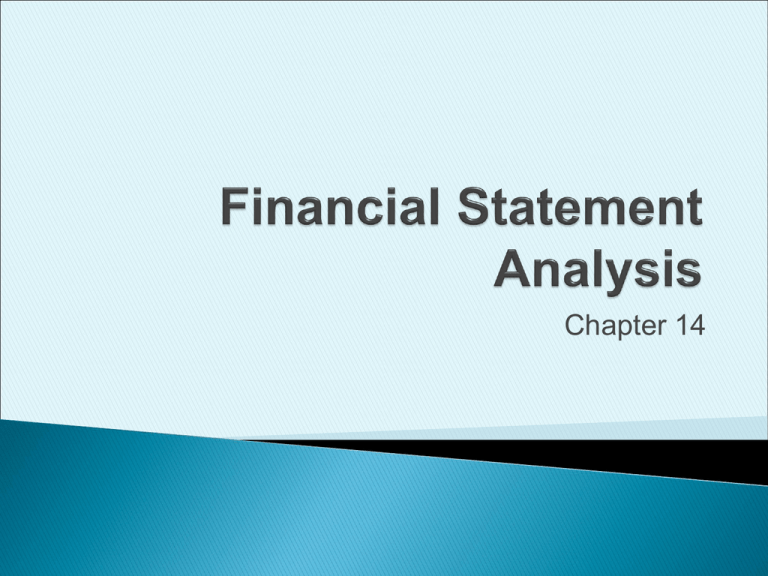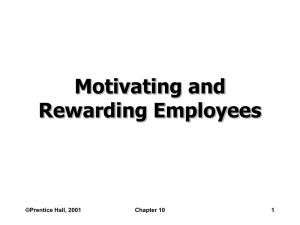
Chapter 14
To make informed decisions about a company
Generally based on comparative financial data
Copyright (c) 2009 Prentice Hall. All rights reserved.
2
Perform a horizontal analysis of financial
statements
Compares two financial statements to determine
dollar and percentage changes
◦ Compute dollar changes
Current year balance
Prior year balance
◦ Compute percentage changes
Dollar change
Base period
Prior year balance
Copyright (c) 2009 Prentice Hall. All rights reserved.
4
Verifine Designs
Comparative Income Statements
Years ended December 31, 2011 and 2010
Net sales revenue
Expenses:
Cost of goods sold
Selling and general expenses
Other expense
Total expenses
Net Income
2011
$428,950
2010
$ 371,000
Dollar
change
$57,950
$ 203,850
99,350
6,750
$ 309,950
$119,000
$ 189,350
93,000
5,000
287,350
$83,650
$14,500
$6,350
$1,750
$22,600
$35,350
Percent
change
15.6%
7.7%
6.8%
35.0%
7.9%
42.3%
Copyright (c) 2009 Prentice Hall. All rights reserved.
5
Form of horizontal analysis
Base year selected and set equal to 100%
Any year $
Trend %
Base year $
Copyright (c) 2009 Prentice Hall. All rights reserved.
6
Perform a vertical analysis of financial statements
Shows relationship of each item to a base amount
on financial statements
Copyright (c) 2009 Prentice Hall. All rights reserved.
8
Prepare and use common-size financial
statements
Any Company
Income Statement
Year ended December 31, 2011
2011
Net sales revenue
Expenses:
Cost of goods sold
Selling and general expenses
Other expense
Total expenses
Net Income
100.0%
47.5%
23.2%
1.6%
72.3%
27.7%
Copyright (c) 2009 Prentice Hall. All rights reserved.
10
Comparing a company with another leading
company
Copyright (c) 2009 Prentice Hall. All rights reserved.
11
Compute the standard financial ratios
Ability to pay
current liabilities
Ability to sell
inventory and
collect
receivables
Measure
profitability
Ability to pay
long-term debt
Analyzing stock
as an investment
Copyright (c) 2009 Prentice Hall. All rights reserved.
13
Working
capital
Current
ratio
Acidtest
ratio
Copyright (c) 2009 Prentice Hall. All rights reserved.
14
Working
Results
in a
capital
dollar
amount
Current
ratio
Current
assets
Current
liabilities
Current
assets
Current
liabilities
Both result in a
ratio
Acid-test
ratio
Cash + short-term
investments + net
current receivables
Current
liabilities
Copyright (c) 2009 Prentice Hall. All rights reserved.
15
Inventory
turnover
Accounts
receivable
turnover
Days’sales-inreceivables
Copyright (c) 2009 Prentice Hall. All rights reserved.
16
Inventory
turnover
Accounts
receivable
turnover
The higher the
turnover,Cost
the quicker
of
it’s selling
goods sold
The higher the
turnover,Net
the credit
quicker
the collections
sales
Average
inventory
Average
accounts
receivable
Copyright (c) 2009 Prentice Hall. All rights reserved.
17
Days’ sales in receivables
Net sales
Average net
accounts
receivable
365
Average
day’s sales
Average
day’s sales
Copyright (c) 2009 Prentice Hall. All rights reserved.
18
Current
ratio
?
Current
assets
Current
liabilities
$173,000
$129,000
Copyright (c) 2009 Prentice Hall. All rights reserved.
19
Acid-test
ratio
Cash + short-term
investments + net
current receivables
Current
liabilities
$18,000 +10,000 + 53,000
$81,000
$129,000
$129,000
?
Copyright (c) 2009 Prentice Hall. All rights reserved.
20
Inventory
turnover
Cost of
goods sold
$319,000
$319,000
Average
inventory
$75,000 + 73,000
2
$74,000
?
Copyright (c) 2009 Prentice Hall. All rights reserved.
21
Copyright (c) 2009 Prentice Hall. All rights reserved.
Days’ sales in receivables
Net sales
365
Average day’s
sales
$463,000
365
$1,268
Average net accounts
receivable
$53,000 +75,000
2
Average day’s sales
$1,268
$64,000
? days
22
Debt ratio
Times-interestearned ratio
Copyright (c) 2009 Prentice Hall. All rights reserved.
23
Debt ratio
Times
interest
earned
Total
liabilities
Total
assets
Operating
income
Interest
expense
Copyright (c) 2009 Prentice Hall. All rights reserved.
24
Return on net
sales
Return on total
assets
Return on
common
stockholders’
equity
Earnings per
share
Copyright (c) 2009 Prentice Hall. All rights reserved.
25
Return on
sales
Net income
Net sales
Net income + interest expense
Return on
assets
Average total assets
Copyright (c) 2009 Prentice Hall. All rights reserved.
26
Net income – preferred dividends
Return on
equity
Average common equity
Net income – preferred dividends
Earnings
per share
Number of common shares outstanding
Copyright (c) 2009 Prentice Hall. All rights reserved.
27
Trading on the equity
Return on equity
is greater
than
Return on assets
Increases profits during good times
Copyright (c) 2009 Prentice Hall. All rights reserved.
28
Price/earnings
ratio (P/E)
Dividend yield
Book value
Copyright (c) 2009 Prentice Hall. All rights reserved.
29
P/E ratio
Dividend
yield
Book value
Market
price per
share
Earnings
per share
Dividends
per share
Common
equity
Market
price per
share
Common
shares
outstanding
Copyright (c) 2009 Prentice Hall. All rights reserved.
30
Suspect movement of sales, inventory, and
receivables
Earnings problems
Decreased cash flow
Too much debt
Inability to collect receivables
Inventory buildup
Copyright (c) 2009 Prentice Hall. All rights reserved.
31







